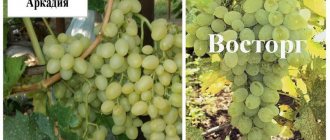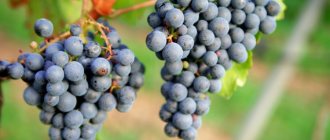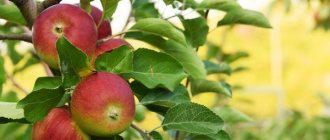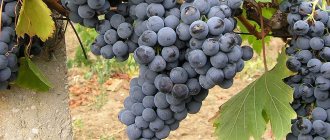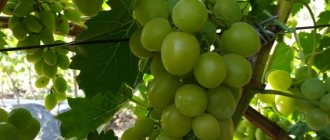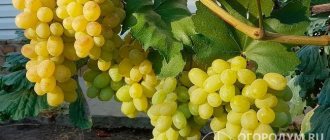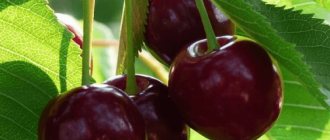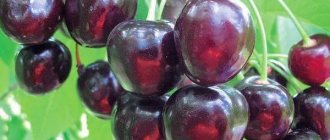Description and features
This variety is characterized by vigorous bushes and bisexual inflorescences. The bunches have an attractive appearance and large sizes. They are distinguished by a conical or cylindrical-conical shape and weigh 600-1200 grams.
The fruits are large and oval in shape. Their weight is 8-10 grams. The berries are characterized by a red-brown color and dense pulp. On top they are covered with a thin and durable peel. The fruits have a pleasant harmonious taste with chocolate notes. The vine ripens well, and cuttings take root easily.
Comparison with analogues
Let’s compare “chocolate” with the main varieties similar to it.
| Sign | Variety | |||
| Chocolate | Lowland | Gorgeous | In memory of the teacher | |
| Ripening period | 130-140 days | 120-130 days | 100 – 110 days | 100 -110 days |
| Frost resistance | Up to -23 °C | Up to -23 °C | Up to -25 °C | Up to -23 °C |
| Yield per bush | 10-15 kg | 6 kg | Up to 10 kg | 10 – 20 kg |
| Bunches | 600-800 g | 700 g | 400 g – 1 kg | 600 g – 2.5 kg |
| Taste | Harmonious, with chocolate flavor | Harmonious and rich, sweet with a slight sourness | Muscat with vanilla | Harmonious with notes of nutmeg |
| Color | Red-brown | Red or pink purple | Gradient from pink to purple | Pink cherry |
| Disease resistance | High | High | Average | Average |
| Shelf life | Several months | Till December | 1 – 2 months | 3 months |
| Sugar content | 16-18% | 17-18% | 18 – 20% | 18 – 20% |
| Acidity | 5-6 g/l | 8-9 g/l | 6 g/l | 6 – 8 g/l |
Reference! The name of the variety “chocolate” among fans has other names: “Maradona red”, “Taifi”.
Characteristics of the variety
Before you decide to plant this crop, you should familiarize yourself with its characteristics.
Frost resistance
Grapes of this variety are characterized by high levels of frost resistance. The bushes are able to tolerate temperature drops down to -25 degrees.
Drought resistance
The crop tolerates short-term drought normally. However, in hot weather it is recommended to water it periodically.
Productivity and fruiting
This variety is characterized by high yield parameters. From 1 hectare it is possible to obtain 150 centners of grapes.
Areas of application of berries
The fruits of this variety are versatile. They can be consumed fresh. The berries are also used to produce wine and various preparations.
Disease resistance
The culture is resistant to oidium, mildew and gray rot. Resistance to these diseases is 3 points.
Transportability
The grapes can easily be transported. The fruits of this variety are suitable for long-term storage.
Cultivation regions
Since 1986, the Chocolate grape variety has been tested at the Russian and Ukrainian state level. The plant became popular due to its ability to remain on the shoots until frost without losing its taste and commercial qualities. On the contrary, over time, a more distinct chocolate flavor appears in the taste, and the color becomes richer.
Since 1986, the Chocolate grape variety has been tested in Russia and Ukraine
You can find grapes of this variety in the south of Russia, Ukraine, and Moldova. It grows well even in northern regions. It is often grown in gardens in the Moscow and Leningrad regions.
Advantages and disadvantages of the variety
The benefits of culture include the following:
- high yield parameters;
- good transportability;
- possibility of growing in poor soil;
- resistance to dry weather;
- beneficial properties of fruits.
The disadvantages of the culture include insufficiently high disease resistance. In addition, the fruits have a long ripening period. Therefore, the crop is grown mainly in the south.
How to plant correctly
In order for the plant to develop normally, it needs to be provided with quality care. Strict adherence to planting recommendations is of no small importance.
Recommendations for choosing deadlines
It is recommended to plant grapes of this variety in spring or autumn. In cold areas, it is better to do this in the first half of May, when warm weather sets in. In a short summer, the grapes will have time to take root and overwinter normally.
In autumn, the plant can be planted in the southern regions.
Site selection and preparation
Seedlings of this variety are planted in a sunny area. It is best to choose the south side. In shady places the culture does not develop well. A lack of lighting will result in the berries not remaining greenish.
The culture requires nutritious soil with a high-quality drainage layer. It is not recommended to grow grapes in swampy areas.
Bushes of this variety grow well in the area of buildings or near fences. Such barriers provide excellent protection from drafts and wind.
See also
Description of the Rochefort grape variety, planting and care features
Read
How to select and prepare planting material
A seedling of this variety can be bought at a specialized store or grown independently from a cutting. In the first case, you should carefully examine the plant. When purchasing a bush with closed roots, you should make sure that the crop has green leaves.
When buying a plant in the cold season, you need to take into account that the cuttings are alive. The buds should be swollen and ready to open. When you cut into the peel, a green structure should be visible. There cannot be any areas of rotting or damage on the seedling itself.
Planting scheme
It is recommended to plant the plant in early May. The timing of the work depends on the climate. To complete the procedure, do the following:
- Prepare a hole for planting in advance. This is done in the fall or at least 1 week in advance. The depth and diameter of the hole should be 80 centimeters.
- Fill the hole halfway with a mixture of fertile soil and compost. Fertilizers containing potassium and phosphorus should be added to the composition. If the soil is too heavy, sand should be added to loosen it. Before filling, it is recommended to add drainage from crushed bricks and stones into the hole.
- Remove the seedling from the pot with a lump of earth. Place in a hole and cover with soil. Water until the soil settles. Apply a mulching layer of peat and sawdust on top.
Rules of care
Normal development of culture is impossible without high-quality and complete care. It must certainly be comprehensive.
Watering mode
Water the crop only as needed. It is recommended to moisten the soil only when the top layer has dried. In hot weather, this should be done at least once a week. In this case, the soil should not acquire a swampy structure.
Be sure to water the plant while the inflorescence is forming.
The soil should also be moistened when the fruits are poured and before harvesting. The last watering is carried out before sheltering for the winter.
After the soil is moistened, a crust usually forms. It is worth getting rid of it to provide the plant roots with moisture and oxygen. During loosening, it is possible to get rid of weeds. To keep the soil moist longer, apply a mulch layer. You can use straw or sawdust for this.
Top dressing
In the first 2-3 years after planting, the plant does not need fertilizers. During this period, the fertilizers that were used during planting are enough. Older crops require the use of complex fertilizers. It is recommended to use organic matter periodically.
Trimming
The grapes of this variety are characterized by rapid growth and therefore require systematic pruning. The manipulation should be performed in autumn and spring. In the first case, you should cut off excess growth and clear the bush of dry branches.
In the spring, formative pruning is performed, which gives the plant its shape and stimulates abundant fruiting.
If there is enough free space, it is recommended to form grapes of this variety into 2 shoulders. The bush is considered quite hardy, therefore it is allowed to leave a maximum of 60 eyes on it. 7-8 eyes are removed from each shoot. This load is considered the maximum permissible.
Protection from birds and insects
This plant may suffer from attacks by birds and insects. To avoid such problems, it is necessary to use special nets to protect the bunches.
Preparing for winter
It is recommended to prepare grapes for winter only in the center or north. However, in cold areas the crop is practically not grown, since its fruits do not have time to ripen. In the south, plantings do not need to be covered.
To prepare the plant for winter, it is worth removing the vine, placing it on a spruce branch and covering it with non-woven material. Special agrofibre is also suitable. When snow falls, it is worth adding additional snow to the plant.
See also
Description of Ruby Jubilee grape variety, planting and care
Read
Preventive spraying
The plant rarely encounters dangerous diseases, but it is not recommended to neglect preventive spraying. Fungicides that are used before and after flowering will help to avoid fungal infections. Medications containing copper help to cope with the problem.
Disease Prevention
The Maradona variety is rarely affected by phylloxera and oidium, but preventive spraying is required. Things are more complicated with fungi. Grapes are afraid of mildew - downy mildew. Spraying the bushes with fungicides before and after flowering helps prevent the spread of the disease. Preparations containing copper work well against fungus. If there are no fungicides at hand, prepare a 1% solution from copper sulfate and treat the plantings.
Reproduction methods
Grapes can be propagated in different ways. To achieve good results, you must strictly adhere to the rules of the procedure.
Cuttings
In this case, it is recommended to do the following:
- Pull the cuttings out of the basement in early February. Trim the bottom.
- Using a sharp knife, scratch the bark near a 2-centimeter cut. This will make it easier for roots to grow.
- Soak the cuttings in water or wrap them in moss and film.
- After roots appear, plant in a pot of soil.
It is recommended to plant the plant in open ground in early May. The specific period depends on climatic conditions.
Graft
The plant can be propagated by grafting. The rootstock can be young or mature. When pruning, the top of the vine should be discarded - it is usually unripe. The remaining lash should be cut with pruning shears to obtain cuttings with 4-5 eyes.
To preserve the juice, the slices should be dipped in hot paraffin and wrapped in a damp cloth. The cuttings should be stored until spring. Then you can get vaccinated. For this variety, the split method is best suited.
Layerings
The plant can be propagated by layering. To do this, it is recommended to take a powerful shoot and bend it to the ground, placing it in a specially prepared trench. Fix and cover with soil. The soil must be moistened periodically. After some time, roots will appear.
History of the selection of Chocolate grapes
The first seedlings of Chocolate grapes appeared in 1981. The creator was P. Ya. Golodrigi. The new variety is the result of crossing Katta Kurgan Kirovabadsky No. 10-51-1 and Antey Magarachsky.
Already in 1986, a new variety was nominated for an exhibition to receive a prize. In the same year, it was transferred for testing under the name Chocolate.
In the sources, grapes are found under different names: Taifi resistant grape, In Memory of Golodriga, Maradona red, Pavel Golodriga.
Currently, this particular variety is grown in many gardens in Moldova, Ukraine and the Russian Federation, but its names may vary.
Diseases and pests
Grapes of this variety periodically face attacks from harmful insects and the development of various diseases.
Oidium
This violation leads to the defeat of the culture. She lags behind in development and becomes covered with a white coating. The risk of developing the disease increases in hot and dry weather. Treating the bunches with crushed sulfur before flowering will help avoid this. It is recommended to feed the soil with potassium and phosphorus.
Mildew
This is one of the most dangerous diseases for grapes, which occurs in conditions of high temperature and humidity. With a slight lesion, the sugar content of the berries is reduced and the ripening of the vine is disrupted. In difficult cases, the plant loses its leaves and its productivity decreases. When the disease develops, Maneb or Zineb are used.
Phylloxera
This pest leads to damage to leaves, roots, and cuttings. Products such as Mitak or Zolon help to cope with parasites. You can also treat the bushes with Karbofos. When the root system is damaged, volatile carbon disulfide is used.
Aphid
These pests attack the leaves of the plant, absorbing their sap. When affected by parasites, the risk of developing fungal diseases significantly increases. Insecticides help control aphids.
Thrips
These small insects cause leaf damage. They are also capable of transmitting viral infections. To protect grapes, insecticidal preparations are used.
Spider mite
These insects absorb the juices of the plant. As a result, the crop lags in growth, its leaves fall off, and the ripening period increases. The drug DNOC, sulfur agents, and systemic acaricides will help to cope with the problem.


